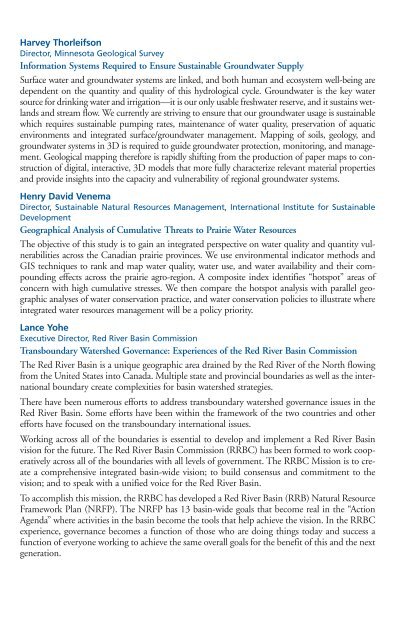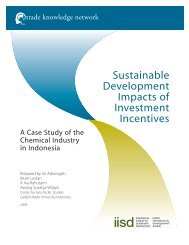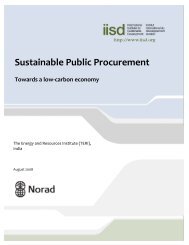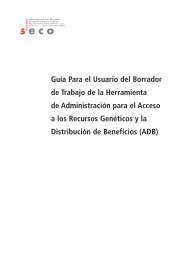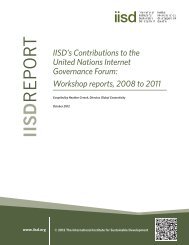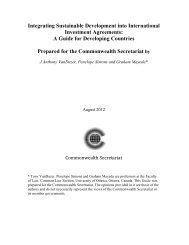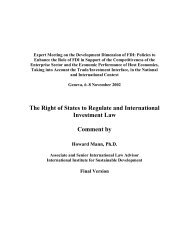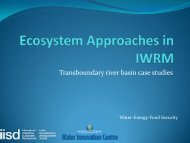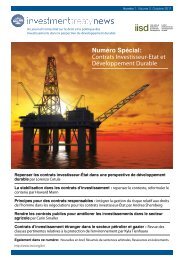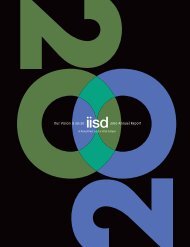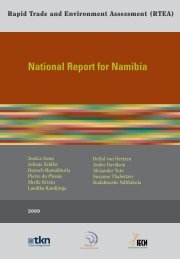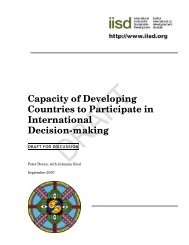Full program - International Institute for Sustainable Development
Full program - International Institute for Sustainable Development
Full program - International Institute for Sustainable Development
You also want an ePaper? Increase the reach of your titles
YUMPU automatically turns print PDFs into web optimized ePapers that Google loves.
Harvey Thorleifson<br />
Director, Minnesota Geological Survey<br />
In<strong>for</strong>mation Systems Required to Ensure <strong>Sustainable</strong> Groundwater Supply<br />
Surface water and groundwater systems are linked, and both human and ecosystem well-being are<br />
dependent on the quantity and quality of this hydrological cycle. Groundwater is the key water<br />
source <strong>for</strong> drinking water and irrigation—it is our only usable freshwater reserve, and it sustains wetlands<br />
and stream flow. We currently are striving to ensure that our groundwater usage is sustainable<br />
which requires sustainable pumping rates, maintenance of water quality, preservation of aquatic<br />
environments and integrated surface/groundwater management. Mapping of soils, geology, and<br />
groundwater systems in 3D is required to guide groundwater protection, monitoring, and management.<br />
Geological mapping there<strong>for</strong>e is rapidly shifting from the production of paper maps to construction<br />
of digital, interactive, 3D models that more fully characterize relevant material properties<br />
and provide insights into the capacity and vulnerability of regional groundwater systems.<br />
Henry David Venema<br />
Director, <strong>Sustainable</strong> Natural Resources Management, <strong>International</strong> <strong>Institute</strong> <strong>for</strong> <strong>Sustainable</strong><br />
<strong>Development</strong><br />
Geographical Analysis of Cumulative Threats to Prairie Water Resources<br />
The objective of this study is to gain an integrated perspective on water quality and quantity vulnerabilities<br />
across the Canadian prairie provinces. We use environmental indicator methods and<br />
GIS techniques to rank and map water quality, water use, and water availability and their compounding<br />
effects across the prairie agro-region. A composite index identifies “hotspot” areas of<br />
concern with high cumulative stresses. We then compare the hotspot analysis with parallel geographic<br />
analyses of water conservation practice, and water conservation policies to illustrate where<br />
integrated water resources management will be a policy priority.<br />
Lance Yohe<br />
Executive Director, Red River Basin Commission<br />
Transboundary Watershed Governance: Experiences of the Red River Basin Commission<br />
The Red River Basin is a unique geographic area drained by the Red River of the North flowing<br />
from the United States into Canada. Multiple state and provincial boundaries as well as the international<br />
boundary create complexities <strong>for</strong> basin watershed strategies.<br />
There have been numerous ef<strong>for</strong>ts to address transboundary watershed governance issues in the<br />
Red River Basin. Some ef<strong>for</strong>ts have been within the framework of the two countries and other<br />
ef<strong>for</strong>ts have focused on the transboundary international issues.<br />
Working across all of the boundaries is essential to develop and implement a Red River Basin<br />
vision <strong>for</strong> the future. The Red River Basin Commission (RRBC) has been <strong>for</strong>med to work cooperatively<br />
across all of the boundaries with all levels of government. The RRBC Mission is to create<br />
a comprehensive integrated basin-wide vision; to build consensus and commitment to the<br />
vision; and to speak with a unified voice <strong>for</strong> the Red River Basin.<br />
To accomplish this mission, the RRBC has developed a Red River Basin (RRB) Natural Resource<br />
Framework Plan (NRFP). The NRFP has 13 basin-wide goals that become real in the “Action<br />
Agenda” where activities in the basin become the tools that help achieve the vision. In the RRBC<br />
experience, governance becomes a function of those who are doing things today and success a<br />
function of everyone working to achieve the same overall goals <strong>for</strong> the benefit of this and the next<br />
generation.


